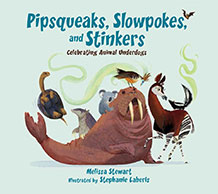 This month we’re featuring Melissa Stewart, author of science books for young readers and a seemingly tireless advocate for reading nonfiction books, particularly expository nonfiction (“5 Kinds of Nonfiction”). Melissa has written more than 180 books in her career, the first of which was published in 1998 and the most recent of which is Pipsqueaks, Slowpokes, and Stinkers: Celebrating Animal Underdogs (illustrated by Stephanie Laberis, published by Peachtree Publishers). We recently put our heads together for an interview addressing our curiosity about Melissa’s books and her work. Pull up a chair to the table and join us!
This month we’re featuring Melissa Stewart, author of science books for young readers and a seemingly tireless advocate for reading nonfiction books, particularly expository nonfiction (“5 Kinds of Nonfiction”). Melissa has written more than 180 books in her career, the first of which was published in 1998 and the most recent of which is Pipsqueaks, Slowpokes, and Stinkers: Celebrating Animal Underdogs (illustrated by Stephanie Laberis, published by Peachtree Publishers). We recently put our heads together for an interview addressing our curiosity about Melissa’s books and her work. Pull up a chair to the table and join us!
Do you work on more than one book at a time?
Yes, I usually work on at least a half dozen books at a time. I might be writing the rough draft of one and revising one or two others. I might be researching one, and waiting for research materials for another. I could be reviewing illustrator sketches or checking layouts or reviewing notes from an editor or copy editor. There’s a lot of juggling. Each day, before I stop working, I make a list of what I plan to work on the next day. This helps to keep me organized.
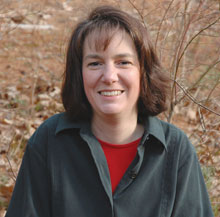
You work on many different types of books within the plethora of knowledge about our natural world. How do you clear your head to work on a joke book after you’ve written about the droughts in our world?
Sometimes it’s a struggle, especially when I need to shift gears between writing with a lively, humorous voice and a more lyrical voice. If my voice is off, I stop writing and start reading to get in the right mindset. It’s sort of like cleansing my palate with sorbet or pickled ginger between different courses of a meal.
You write for a variety of publishers including Peachtree Publishers, National Geographic Kids, Beach Lane Books, and HarperCollins. Do you pitch your ideas to these companies or do they come to you with ideas for the books they’d like?
A little bit of both. When publishers have a large mass market series, such as National Geographic Readers or HarperCollins’s Let’s-Read-and-Find-Out-Science®, they usually decide what topics they would like to add and then search for a writer. But for picture books and other trade books, I develop the idea. For picture books, I need to submit the complete manuscript, and then the publisher may accept it or they may reject it. For longer books, I submit a proposal with an outline and writing sample.
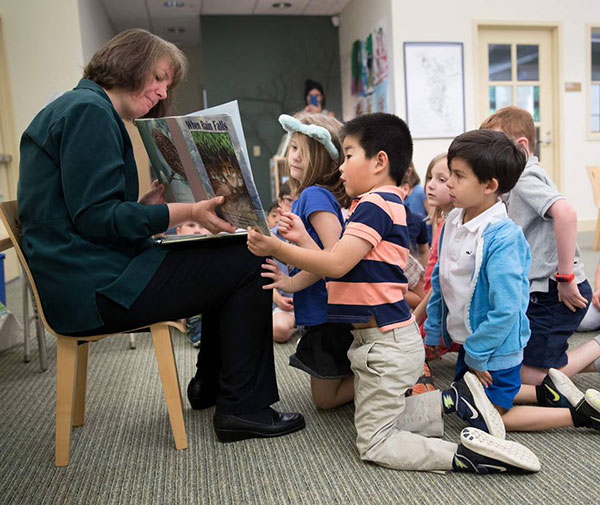
When you’re writing a book that a publisher hired you to write, do you have parameters within which you need to stay?
Yes. They give me a word count and usually tell me what text features to include. I use existing books in the series as models.
Do you find that difficult to do?
No. I find it comforting to have guidelines. It’s sort of like putting together a jigsaw puzzle. All the pieces are there. I just have to figure out the right way to put them together.
With picture books, I’m inventing the puzzle. I find that challenging, but I enjoy being able to experiment and play. It’s a more creative experience.
How do you keep your research organized?
I don’t really have a good system. I type all my notes into a Word file. Over time, it becomes unwieldy.
Before I start writing, I think about the major categories of information I’ll need. Then I cut and paste, cut and paste to create major chunks of related information. Depending on the book, even these chunks can still be unwieldy. Thank goodness Word allows me to do searches to find exactly the information I need.
Sometimes I use index cards or sticky notes to help me decide the order in which these chunks will be presented in the book. I like that I can physically move them around.
Do you return to that research when you’re writing a new book?
Sometimes I try. After all, it would be more efficient, but there are two reasons that it usually doesn’t work out.
- Because our knowledge of the world is changing so quickly, notes I took 5 or even 3 years ago may be out of date.
- Even when I include the same animal in two books, my hook is inevitably different, so my notes may not have the specific details I need.
Who finds the photos that are included in your books?
Sometimes me. Sometimes a photo researcher who works for the publishing company. And sometimes we work together. It depends on the publisher and the project.
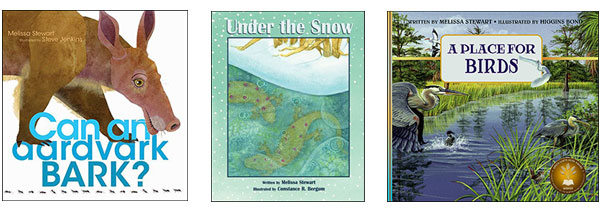
Do you have any input for the illustrators who have worked on books such as Can an Aardvark Bark? and Under the Snow and A Place for Birds?
Sometimes I play a role in selecting the illustrator, and sometimes I don’t. It depends on the publisher and the project. Sometimes I provide a package of reference materials for the illustrator.
Because I’m the content expert, I always have an opportunity to review the illustrator’s sketches and comment on anything that isn’t scientifically sound. It isn’t unusual for the illustrator to do several sets of sketches. S/he keeps working until all the details in the art are accurate.
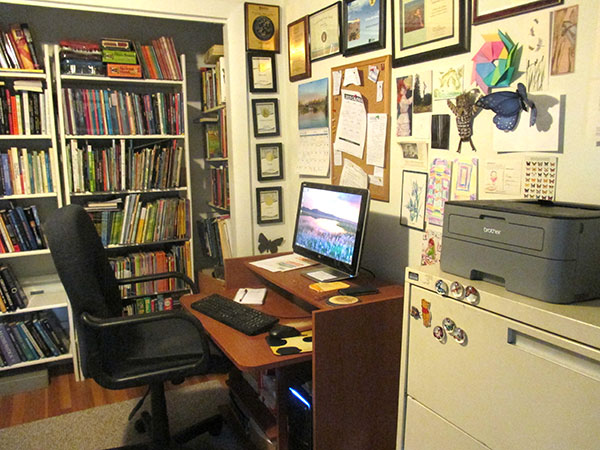
If you could break your week down into the percentages of what you do, how much time do you spend on the different tasks required of a successful writer?
This has shifted a lot over the years. When my first book was published 20 years ago, authors weren’t expected to play a role in marketing. Most children’s books were sold to schools and libraries. But in the early 2000s, school book budgets were slashed and many school librarians lost their jobs. For a while, there were several large brick-and-mortar bookstore chains, and they were major players in the market. But now, most of them are gone.
Today social media is exploding and authors are expected to be actively involved in selling their books. And so I spend a lot of time blogging and tweeting and developing materials for my website. That means I have less time to actually work on books.
While there really is no typical day or week, I can say that I now spend only about 50 percent of my time working on books. The rest of the time is devoted to marketing, speaking at schools, attending conferences, and reading recently published children’s books.
Of the time I do spend working on books, probably about 50 percent of the time is spent physically writing. The rest of the time, I’m doing research, developing ideas for new projects, or reading adult books and articles about science.
What’s your favorite aspect of your career?
The physical act of writing, especially those magical hours “spent in the flow.” But a close second is spending time in schools speaking with and listening to kids.
What do you wish were different about your career?
I don’t think anyone likes rejections, but it’s an inevitable part of the writing process.
If you could select one of your backlist titles, which book would you like to see people reading with more frequency? Can you tell us why?
Because science is always changing, some of my older books contain information that is out of date. In fact, I sometimes cheer when I find out a title is going out of print. I’m more than happy to have young readers focus on titles I’ve published in the last 5 or 6 years.
Curious about Melissa’s books? Visit her website.
Educators, don’t miss the many, many resources Melissa has made available for you. Her site is a veritable treasure lode!

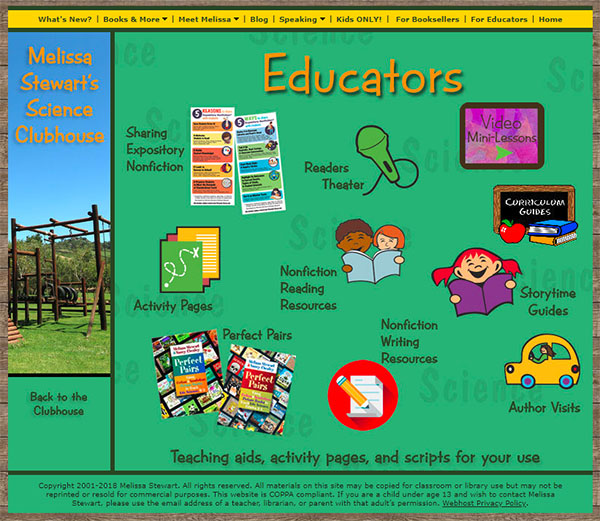
Thanks for the interview! I love Melissa’s books & am excited to read Pipsqueaks 🙂